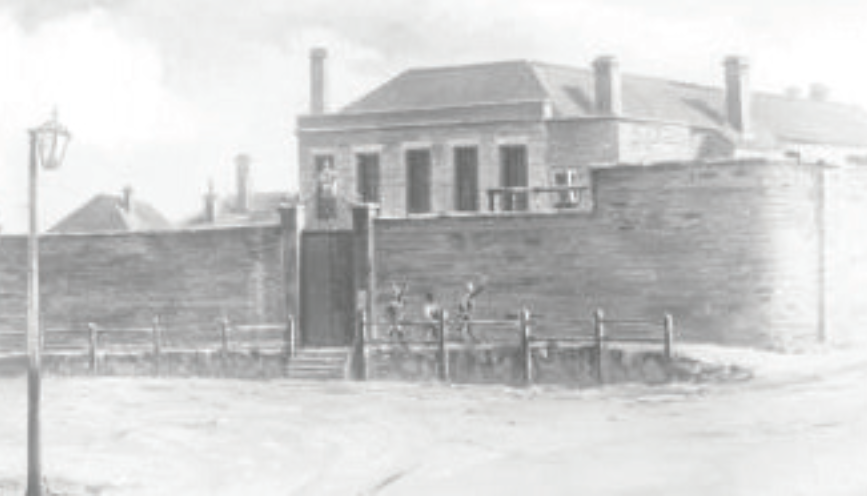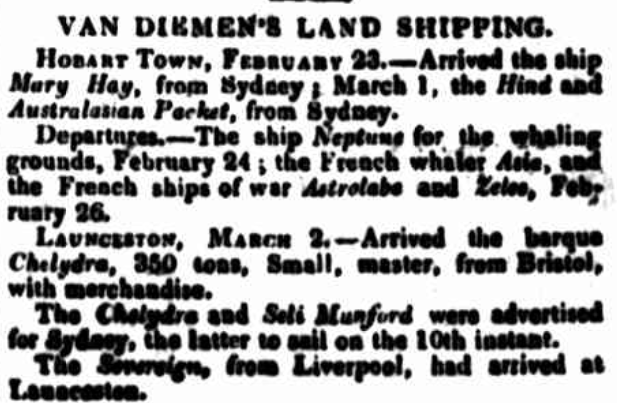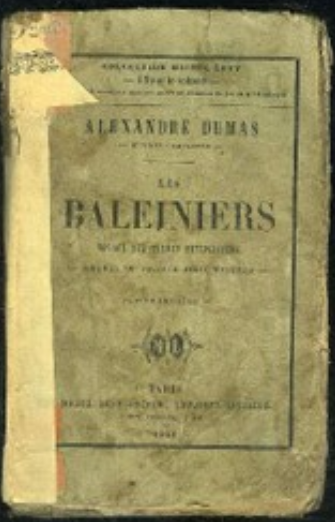
Hobart. Follow Murray Street towards Salamanca. Stay on the right-hand side. Cross Macquarie Street. In front of you is a plaque noting the site of the old Hobart Town Gaol (above, a decade or so after the executions). Where there are building facades there was a high wall. On this corner of the jail, on the other side of the wall, was the gallows. On execution days the prisoners would mount the steps and, standing on the platform where they would die, would be partly visible to the spectators on the street. Glance opposite and from the upper storey of the elegant public buildings, gentlemen, enjoying breakfast, would observe the hangings. The roadway between would have been thronged with observers. There is an interesting text describing an execution here which is marked with the fingerprints of Alexandre Dumas: that too is interesting because he was never in Hobart.
This article appeared in a recent Quadrant.
Click here to subscribe
Hobart. In 2023 it is a city with a history-hating museum and a statue-killing vandal Lord Mayor (I blame her parents)—a typically conservative-unwelcoming Australian city. In 1840 it was a more curious and remarkable town. In February and March 1840 there were nine French ships moored in the port—two were warships, the Zélée and the Astrolabe, which after carrying out their polar expedition were preparing for their return to France. Of the other vessels five were whalers and on board one of these, the Asia under Captain Jay, was a twenty-six-year-old surgeon, Felix Maynard. The Asia had left Le Havre the previous June and was in Hobart from February 5 to 26 when it sailed for the fishing grounds in New Zealand waters.

Some fifteen or so years later Maynard approached Dumas, who was then editing his literary journal Le Mousquetaire, with a collection of writings based on his travels. Dumas was enthusiastic and edited, contributed to and published the texts. They were presented as being from the journal of Dr Maynard and it was never clear how much had been reshaped by Dumas or recreated as fiction-nonfiction. Later collected in book form in 1861 as Les baleiniers, voyage aux terres antipodiques, they were translated into English and published as The Whalers in 1937 by a New Zealand pharmacist and Dumas enthusiast, Frank Wild Reed (1874–1953)—his internationally significant Dumas collection is one of the treasures of the Auckland Public Library. Reed’s introduction cites a note by Dumas which suggests his extensive contribution to the published texts: “I produced something like 4500 lines with Dr Maynard.”
Several early chapters of The Whalers deal with Hobart and Van Diemen’s Land. Other chapters on New Zealand, which is the main focus of the work, provide interesting and informative chapters on folk arts such as cannibalism, tattooing and the preservation of human heads. The texts may not have come from an actual journal, as no years are given and internal dating is inconsistent. For Maynard’s visit to Van Diemen’s Land I have selected February 1840 as the probable date because the Asia under Captain Jay was in Hobart and four men were executed at the jail. They were the first hangings carried out in Hobart since June 1838. After their Supreme Court trials the four men were sentenced to death, and to be anatomised. There is also one detail (as will be seen) given by Maynard that possibly confirms this is the execution he witnessed.
The Asia arrived in Hobart after the trials and Maynard, who spoke no English, would have known little about the men he saw die.
John Davis (a convict aged twenty-seven) and John Riley (a free settler aged thirty-one) were convicted of the murder and robbery of James Matthews after a night of drinking. “Horrible Murder” was a newspaper headline.
Edward Martin (twenty-five) had wounded Sergeant George Newman in the neck. He was among prisoners being loaded by soldiers onto the brig Tamar in Hobart to be taken to Port Arthur. As they went on board Newman asked each man if he had “anything about him”. When his turn came, Martin replied, “Yes, I have got that for you.” He stabbed the soldier, not seriously, and in the ensuing struggle his weapon, a knife, fell overboard into the sea. He explained himself to his victim: “I never saw you before, and I owe you no ill-will, but I wanted to take your life, as I was tired of my own.” He was convicted of attempted murder.
George Pettit (nineteen). An early-morning argument broke out at O’Connor’s farm near Oatlands. The overseer, John Paul, was harrying a young assigned convict, George Pettit, to finish his breakfast and go to work. Pettit gave a surly response. Paul called him a “saucy rascal” and said he would report him to Mr O’Connor. Pettit responded that he did not give a damn and the older man “threatened to take him to Oatlands [to appear before a magistrate] and get the flesh cut off his back”. When Paul returned to his room Pettit loaded an old musket and followed. Confronting Paul, he ordered him to kneel. The overseer pushed forward, trying to close the door between them and the gun was fired. The overseer took a full blast in his chest and across the arm he had raised to protect himself. Pettit withdrew behind a haystack to reload and returned to find the mortally wounded man lying on the ground in his blood. He fled to Oatlands but was soon captured by the constables. Returning with them to the farm he was asked why he had shot Paul and he answered, “Because he was an old tyrant.”
Taken into Paul’s room, he cried, and said he was sorry. “Ah George,” said Paul, “it is too late now.” Paul was in agony until he died just before midnight, his upper body ripped open and, like his arm, studded with shot. An inquest was held the next day. Before being taken to Hobart, Pettit dictated a letter to his father in England:
Van Diemen’s Land, Oatlands, January 29, 1840
My Dear Father,
I regret to state to you my misfortunes since I come to this country, but my situation now I don’t expect to remain in this world more than a few weeks, as I am fully committed to take my trial for wilful murder at the next criminal court at Hobart Town. I have been signed off [assigned] to Mr. O’Connor, at Peter’s Pass, and the overseer and I had some words on the 27th of this month, in consequence of not going to work soon enough in the morning, and threatening to bring me in to Oatlands before the Magistrate, for which reason I loaded my piece and shot him in the breast, also in the hand; the man died at 12 o’clock the same night; the inquest was held on him the day after, on the 28th day of January. My kind love to my sisters and brothers hoping they won’t fret as it will do no good now. I’ve seen Mathew Mason, he is residing in Launceston doing very well. I remain, my dear Father, your affectionate Son until death,
George Pettit, His Mark
The murder occurred on a Monday, the Supreme Court trial was held in Hobart the following Monday, and on Monday two weeks later Pettit was hanged. It took the trial jury two minutes to reach their verdict. The young man presented no defence. The man he killed had been given a quiet and private burial on O’Connor’s farm by his wife.
Of the four men being executed it was probably the case of Pettit that created most interest because of its brutality and the youth and good looks of the murderer. Every contemporary account of the crime makes a reference to his appearance—a fallen angel: “the wretched criminal is a mere lad, scarcely, as we learn, eighteen years of age, and, strange to say, of a rather prepossessing character”. The convict indent records gave him hazel eyes—the record keeper must have been impressed. He was five foot four and a half inches tall, which may have added to the impression that a young boy was being dealt with. He had black hair and a dark complexion. In 1838 he had been sentenced in England to fourteen years transportation for stealing from a dwelling house—he had previously been in trouble for, at different times, stealing lead and green  peas. The conduct report from the prison hulk called him a “very bad character with respectable connections” while the surgeon on the voyage to Hobart noted that he was “well behaved”.
peas. The conduct report from the prison hulk called him a “very bad character with respectable connections” while the surgeon on the voyage to Hobart noted that he was “well behaved”.
After the Supreme Court trials the Chief Justice, Sir John Pedder (right), pronounced the death sentences on the four men but when he dealt with George Pettit the Hobart Town Advertiser recorded an unusual scene—an extraordinary moment of humanity (what Dumas could have made of this):
George Pettit, for the murder of Mr Paul, was then brought up. The youth, whose appearance excited so much interest on his trial, appeared much altered since his conviction. A wasted form and dejected countenance bespoke that he had been painfully aware of the horrors of his situation. His Honor’s address was heart-rending—less from the actual words spoken, than the manner and emotion of the speaker, which suffused his eyes with tears, and nearly choked his utterance. To have to pass sentence upon one so young, and for such an offence, had (his Honor observed) moved him exceedingly, and it might appear strange that, after passing the same sentence on the two men who had left the dock, his feelings should now be so much excited. But the cases were so different in their complexion, this crime being committed as it were without a motive, and, in the language of the indictment, “at the instigation of the devil”. It was an awful instance of the effects of passion and revenge, and should be a warning to all to repress the first symptoms of rising anger. The usual sentence of death was then pronounced. The prisoner seemed deeply affected.
While awaiting death the boy admitted the truth of the evidence given against him and said “he had committed almost every species of sin that could be named”. Which may be a reference to his time among the other convicts and the usual Van Diemen’s Land vice.
Felix Maynard’s account of the execution shows little knowledge of the men and their crimes. He describes the scene and the construction of the scaffold with “four ends of new rope, well soaped and gleaming in the sunlight”. They were, he thought, three bushrangers and “the fourth worked at Port Arthur, and had  murdered a keeper for taking a little tobacco from him”. A large crowd assembled to see the executions on a Monday morning (Maynard says it was a Saturday), and an informative person in the crowd is used to set the scene:
murdered a keeper for taking a little tobacco from him”. A large crowd assembled to see the executions on a Monday morning (Maynard says it was a Saturday), and an informative person in the crowd is used to set the scene:
My obliging neighbour, who had already supplied these details [on the prisoners], was good enough, at my request, to continue the office of cicerone. He explained to me that, behind the wall and concealed by it, there was a trapped platform upon which the condemned mounted, so that the top of the wall served them as a balustrade; then, when the ropes were around their necks, the platform would be tripped.
“Thus you understand what will happen,” my neighbour concluded.
I understood perfectly.
The execution was late:
The crowd began to grumble in an ignoble manner noticeable only in English mobs … Finally, at ten minutes past nine, the drums beat. Thirty red-coats, thirty colossal Irishmen, commanded by a frail gentleman in a blue tunic, debouched from David [Davey] Street and arranged themselves in line on the square at the foot of the prison wall and below the gallows. The officer yelled a command; the Irishmen carried arms, and a gentleman in a yellow great-coat and a grey hat appeared on the scaffold and bowed gracefully to the crowd. He was the executioner.
He placed his hat on the parapet, passed his hand through his hair to throw it coquettishly to one side of his face, drew from his pocket a little bundle of white linen, which he placed in his hat, bent towards the interior of the prison and made a sign.
There is a novelistic arrangement of the scene and even some lighter relief to the scene as Captain Jay appears to view the execution. When he taps the narrator on the shoulder he is chewing “an enormous quid of tobacco”. And the action continues:
A murmur arose, for the sign just made by the executioner was intended to inform the governor of the prison that all was ready and that they were only waiting for the condemned. The result was that these latter appeared slowly, one after the other, behind the wall. They were four young men, the oldest of whom might be thirty. Their hands were free, but their elbows were fastened behind their backs.
The placing of the ropes is praised: “This is a perfection which does honour to the English genius. It is comfort introduced into the conditions of the death penalty.” The sentences are read out, priests of different religions appear and offer prayers and the crowd shouts farewells, “Bravo, Peter! … Bravo John! … Bravo Tom! … Good-bye! Good-bye! …”
The executioner covers their faces with the white linen and the men and priests pray:
I looked at Captain Jay; he was as white as the serviettes covering the faces of the condemned men.
The crowd began to grow irritated at the slowness of the execution; this parody of death was hideous and made the most hardened shudder. It lasted for more than a quarter of an hour. The executioner understood the murmur; he examined the ropes, he dismissed the sheriff and the priests, bowed and resumed his hat. Then, seizing one of the posts between his arms, he stamped his foot and everything disappeared. For a second the ropes swayed to and fro, but, almost immediately, they stretched and became stiff and motionless like the cord of the sounding lead.
Among the cries uttered in the crowd I recognized that of Captain Jay. I turned towards him. He appeared to be suffocating.
“What is the matter then, captain?” I asked.
“Great thunder,” said he, “I have swallowed my quid.”
I thought he was joking.
The jailor opened the great doors of the prison, so that the spectators might assure themselves of the death of the criminals.
The captain hurried back down to the harbour where Dr Maynard would soon follow and treat him for nicotine poisoning before the ship sailed for New Zealand that same morning. In reality the Asia was in port another week and sailed the day three crewmen, who had been reported absent without leave, were released from the House of Correction where they had been sentenced to spend fourteen uncomfortable days by a Hobart magistrate.
Maynard “followed the crowd. I then saw those who had been hanged, straight and stiff, with their feet about a yard from the ground. The gentleman executioner stood beside them, like the head of the file, seeming to say to the curious: ‘That was an easy send off now! … I reckon that could be called a handsome job!’” With doctorly precision he noted that on the corpses, “The tongue protruded half an inch from the corner of the mouth.”
Though some parts of the account don’t comfortably fit the newspaper accounts of the 1840 execution, one detail suggests that this was the incident the doctor witnessed. John Riley was a married man and his death left his family destitute. There was sympathy for their situation. The governor, Sir John Franklin, allowed them rations from the government stores and a public appeal was made for them. It is surely this woman with her son and three daughters who Maynard noticed and remembered:
As I left the prison yard, I passed near a woman and four children who were weeping, crouched at the foot of a spur-post. Beside them, on a tin plate, gleamed some pieces of copper money. Someone said it was the family of one of the men who had been hanged. Another remarked: “It is pay-day.”
Perhaps the person who provided that final curtain fall comment was Dumas—or not.
Sources: Dr Felix Maynard and Alexandre Dumas, The Whalers (1937) translated by F.W. Reed. Trove online newspaper database maintained by the National Library of Australia for contemporary Van Diemen’s Land newspapers.
 Sign In
Sign In 0 Items (
0 Items ( Search
Search










“…the usual Van Diemen’s Land vice” sent me searching for confirmation it was referring to sodomy, although how that could be “the usual” is beyond my comprehension.
.
I ended up reading an ABC article! Interestingly it claimed the Port Arthur jail was built to keep the prisoners separated and thereby put an end to such sinning.